MKT01760: Reflection on Two Tourism Discussion Papers
VerifiedAdded on 2022/10/19
|8
|2192
|320
Report
AI Summary
This report provides a comprehensive analysis of two discussion papers related to tourism. The first paper, "Sustainable Tourism for Development (DPSTD)", focuses on the economic, social, and environmental dimensions of sustainable tourism, highlighting its contributions to the global economy and the importance of effective planning and management. The report examines the paper's policy cycle, content, and its emphasis on stakeholder engagement and cultural heritage preservation. The second paper, "Tourism Impacts and the future of the Tourism Cost Adjustor (TIFTCA)", explores the role of the State Grants Commission of Australia in reviewing tourism's effects and forecasting for the Tourism Cost Adjustor. The analysis includes a comparison of the policy planning cycles, content, and data-driven findings of both papers, including the use of data and statistics to assess the impact of tourism on municipalities. The report also reflects on how these papers have broadened the author's knowledge of tourism planning environments, the challenges and opportunities in sustainable development, and the use of data in policy making.
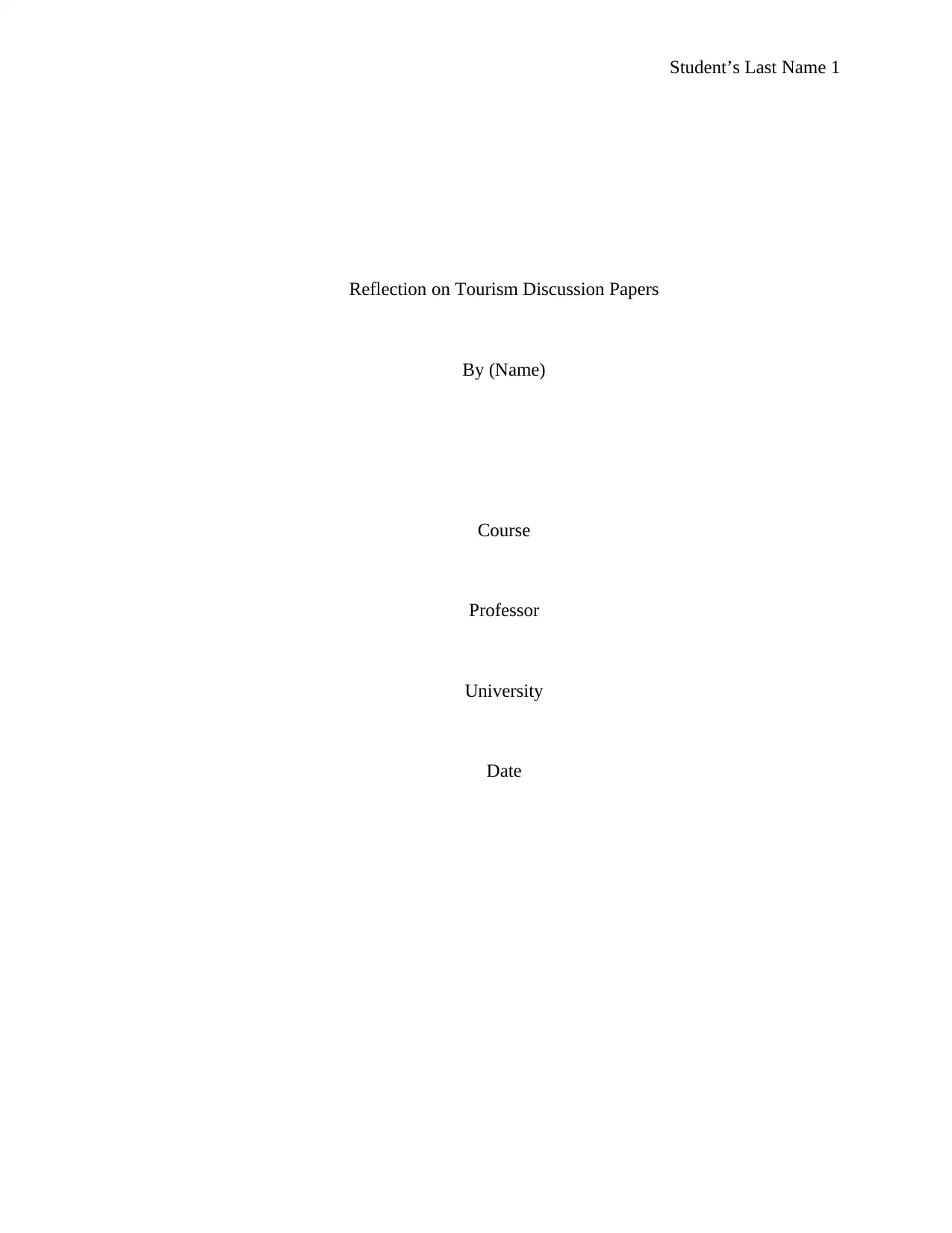
Student’s Last Name 1
Reflection on Tourism Discussion Papers
By (Name)
Course
Professor
University
Date
Reflection on Tourism Discussion Papers
By (Name)
Course
Professor
University
Date
Paraphrase This Document
Need a fresh take? Get an instant paraphrase of this document with our AI Paraphraser
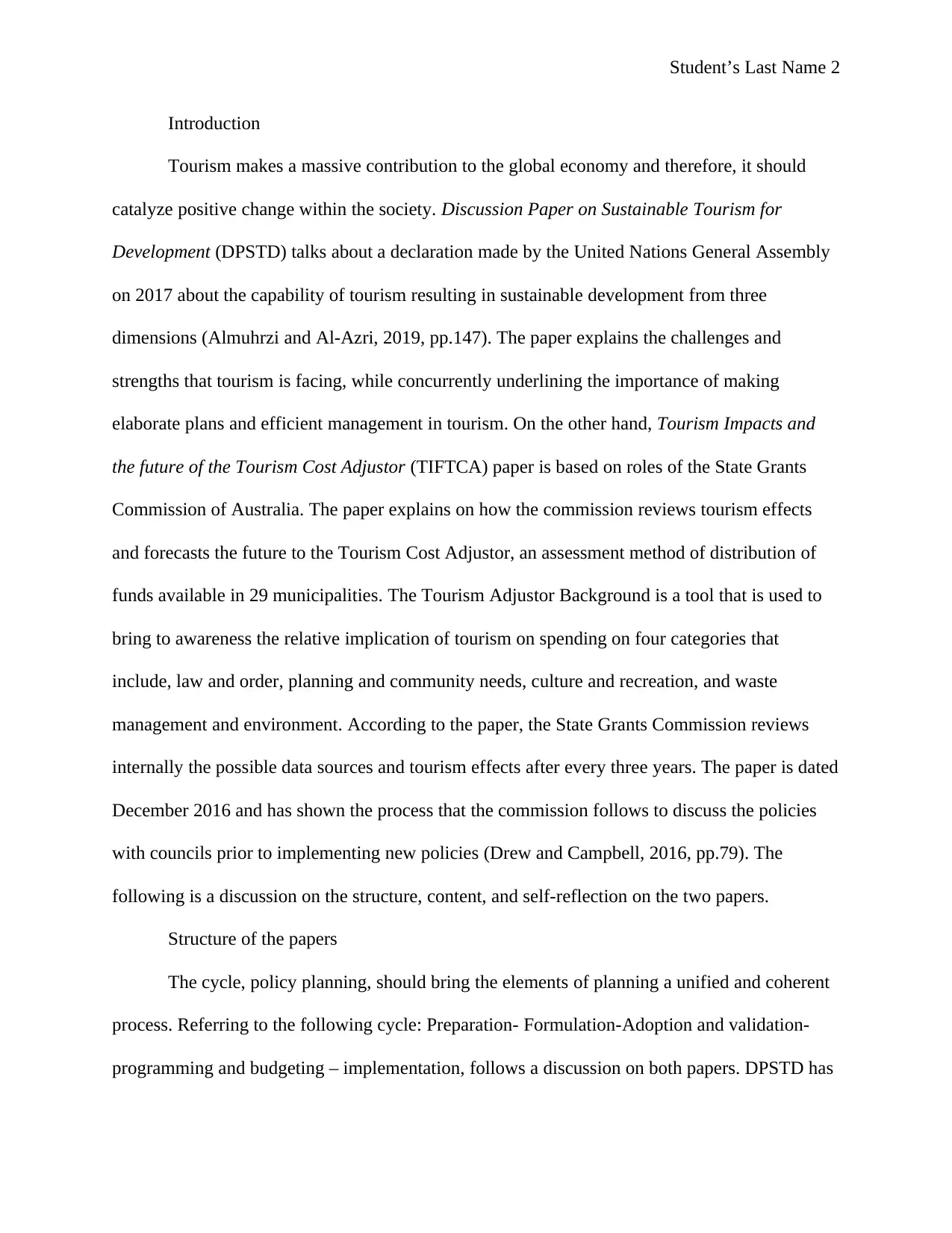
Student’s Last Name 2
Introduction
Tourism makes a massive contribution to the global economy and therefore, it should
catalyze positive change within the society. Discussion Paper on Sustainable Tourism for
Development (DPSTD) talks about a declaration made by the United Nations General Assembly
on 2017 about the capability of tourism resulting in sustainable development from three
dimensions (Almuhrzi and Al-Azri, 2019, pp.147). The paper explains the challenges and
strengths that tourism is facing, while concurrently underlining the importance of making
elaborate plans and efficient management in tourism. On the other hand, Tourism Impacts and
the future of the Tourism Cost Adjustor (TIFTCA) paper is based on roles of the State Grants
Commission of Australia. The paper explains on how the commission reviews tourism effects
and forecasts the future to the Tourism Cost Adjustor, an assessment method of distribution of
funds available in 29 municipalities. The Tourism Adjustor Background is a tool that is used to
bring to awareness the relative implication of tourism on spending on four categories that
include, law and order, planning and community needs, culture and recreation, and waste
management and environment. According to the paper, the State Grants Commission reviews
internally the possible data sources and tourism effects after every three years. The paper is dated
December 2016 and has shown the process that the commission follows to discuss the policies
with councils prior to implementing new policies (Drew and Campbell, 2016, pp.79). The
following is a discussion on the structure, content, and self-reflection on the two papers.
Structure of the papers
The cycle, policy planning, should bring the elements of planning a unified and coherent
process. Referring to the following cycle: Preparation- Formulation-Adoption and validation-
programming and budgeting – implementation, follows a discussion on both papers. DPSTD has
Introduction
Tourism makes a massive contribution to the global economy and therefore, it should
catalyze positive change within the society. Discussion Paper on Sustainable Tourism for
Development (DPSTD) talks about a declaration made by the United Nations General Assembly
on 2017 about the capability of tourism resulting in sustainable development from three
dimensions (Almuhrzi and Al-Azri, 2019, pp.147). The paper explains the challenges and
strengths that tourism is facing, while concurrently underlining the importance of making
elaborate plans and efficient management in tourism. On the other hand, Tourism Impacts and
the future of the Tourism Cost Adjustor (TIFTCA) paper is based on roles of the State Grants
Commission of Australia. The paper explains on how the commission reviews tourism effects
and forecasts the future to the Tourism Cost Adjustor, an assessment method of distribution of
funds available in 29 municipalities. The Tourism Adjustor Background is a tool that is used to
bring to awareness the relative implication of tourism on spending on four categories that
include, law and order, planning and community needs, culture and recreation, and waste
management and environment. According to the paper, the State Grants Commission reviews
internally the possible data sources and tourism effects after every three years. The paper is dated
December 2016 and has shown the process that the commission follows to discuss the policies
with councils prior to implementing new policies (Drew and Campbell, 2016, pp.79). The
following is a discussion on the structure, content, and self-reflection on the two papers.
Structure of the papers
The cycle, policy planning, should bring the elements of planning a unified and coherent
process. Referring to the following cycle: Preparation- Formulation-Adoption and validation-
programming and budgeting – implementation, follows a discussion on both papers. DPSTD has
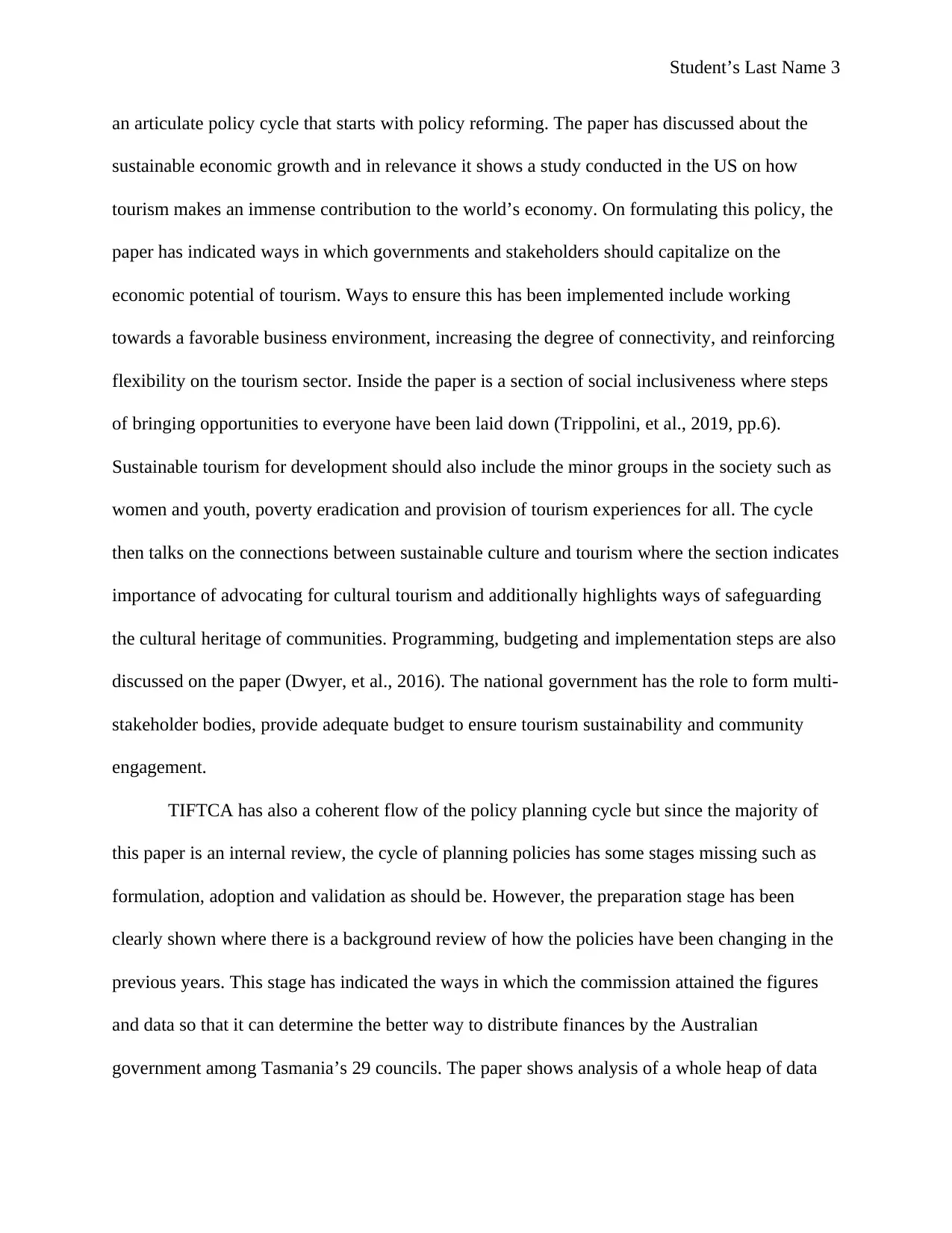
Student’s Last Name 3
an articulate policy cycle that starts with policy reforming. The paper has discussed about the
sustainable economic growth and in relevance it shows a study conducted in the US on how
tourism makes an immense contribution to the world’s economy. On formulating this policy, the
paper has indicated ways in which governments and stakeholders should capitalize on the
economic potential of tourism. Ways to ensure this has been implemented include working
towards a favorable business environment, increasing the degree of connectivity, and reinforcing
flexibility on the tourism sector. Inside the paper is a section of social inclusiveness where steps
of bringing opportunities to everyone have been laid down (Trippolini, et al., 2019, pp.6).
Sustainable tourism for development should also include the minor groups in the society such as
women and youth, poverty eradication and provision of tourism experiences for all. The cycle
then talks on the connections between sustainable culture and tourism where the section indicates
importance of advocating for cultural tourism and additionally highlights ways of safeguarding
the cultural heritage of communities. Programming, budgeting and implementation steps are also
discussed on the paper (Dwyer, et al., 2016). The national government has the role to form multi-
stakeholder bodies, provide adequate budget to ensure tourism sustainability and community
engagement.
TIFTCA has also a coherent flow of the policy planning cycle but since the majority of
this paper is an internal review, the cycle of planning policies has some stages missing such as
formulation, adoption and validation as should be. However, the preparation stage has been
clearly shown where there is a background review of how the policies have been changing in the
previous years. This stage has indicated the ways in which the commission attained the figures
and data so that it can determine the better way to distribute finances by the Australian
government among Tasmania’s 29 councils. The paper shows analysis of a whole heap of data
an articulate policy cycle that starts with policy reforming. The paper has discussed about the
sustainable economic growth and in relevance it shows a study conducted in the US on how
tourism makes an immense contribution to the world’s economy. On formulating this policy, the
paper has indicated ways in which governments and stakeholders should capitalize on the
economic potential of tourism. Ways to ensure this has been implemented include working
towards a favorable business environment, increasing the degree of connectivity, and reinforcing
flexibility on the tourism sector. Inside the paper is a section of social inclusiveness where steps
of bringing opportunities to everyone have been laid down (Trippolini, et al., 2019, pp.6).
Sustainable tourism for development should also include the minor groups in the society such as
women and youth, poverty eradication and provision of tourism experiences for all. The cycle
then talks on the connections between sustainable culture and tourism where the section indicates
importance of advocating for cultural tourism and additionally highlights ways of safeguarding
the cultural heritage of communities. Programming, budgeting and implementation steps are also
discussed on the paper (Dwyer, et al., 2016). The national government has the role to form multi-
stakeholder bodies, provide adequate budget to ensure tourism sustainability and community
engagement.
TIFTCA has also a coherent flow of the policy planning cycle but since the majority of
this paper is an internal review, the cycle of planning policies has some stages missing such as
formulation, adoption and validation as should be. However, the preparation stage has been
clearly shown where there is a background review of how the policies have been changing in the
previous years. This stage has indicated the ways in which the commission attained the figures
and data so that it can determine the better way to distribute finances by the Australian
government among Tasmania’s 29 councils. The paper shows analysis of a whole heap of data
⊘ This is a preview!⊘
Do you want full access?
Subscribe today to unlock all pages.

Trusted by 1+ million students worldwide
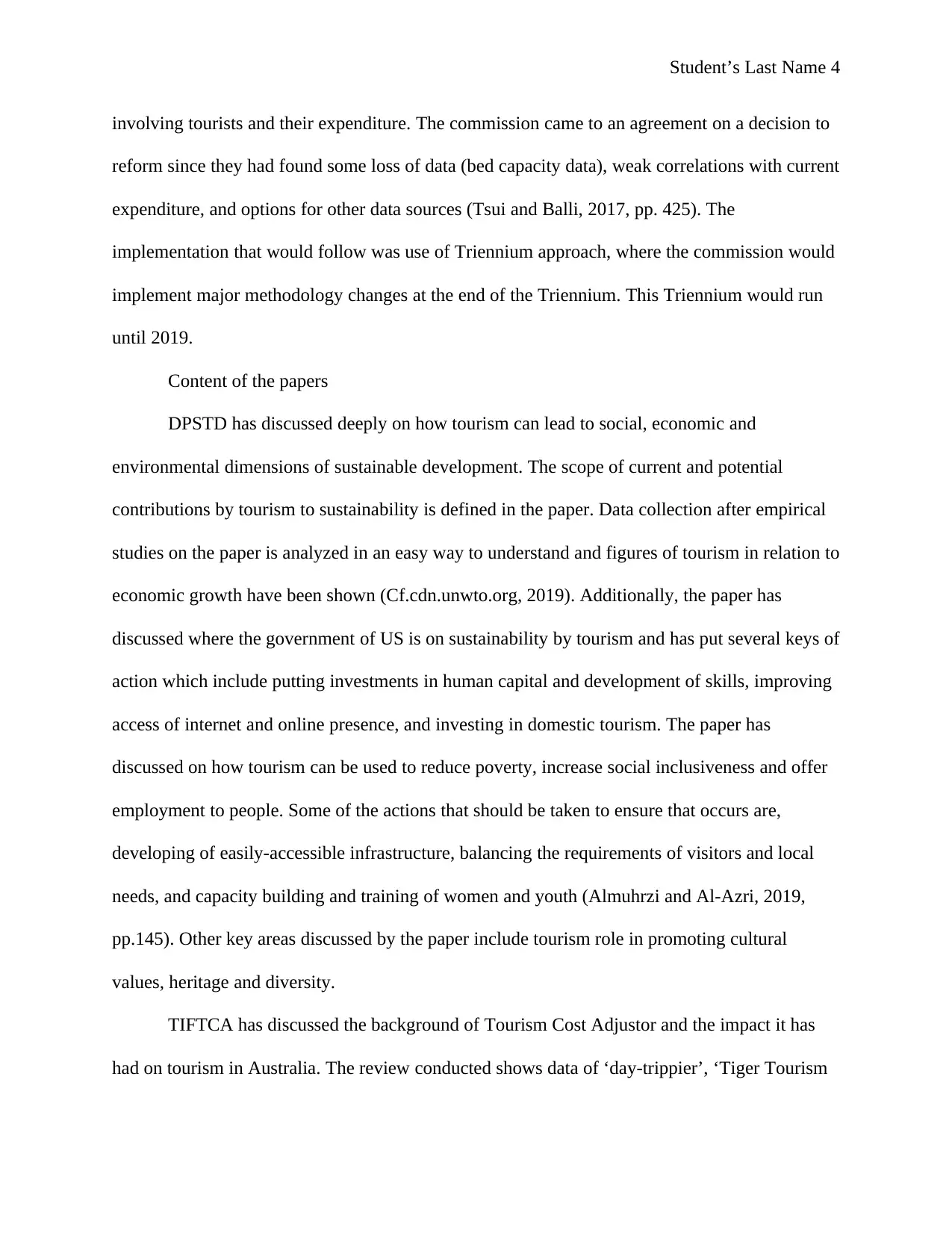
Student’s Last Name 4
involving tourists and their expenditure. The commission came to an agreement on a decision to
reform since they had found some loss of data (bed capacity data), weak correlations with current
expenditure, and options for other data sources (Tsui and Balli, 2017, pp. 425). The
implementation that would follow was use of Triennium approach, where the commission would
implement major methodology changes at the end of the Triennium. This Triennium would run
until 2019.
Content of the papers
DPSTD has discussed deeply on how tourism can lead to social, economic and
environmental dimensions of sustainable development. The scope of current and potential
contributions by tourism to sustainability is defined in the paper. Data collection after empirical
studies on the paper is analyzed in an easy way to understand and figures of tourism in relation to
economic growth have been shown (Cf.cdn.unwto.org, 2019). Additionally, the paper has
discussed where the government of US is on sustainability by tourism and has put several keys of
action which include putting investments in human capital and development of skills, improving
access of internet and online presence, and investing in domestic tourism. The paper has
discussed on how tourism can be used to reduce poverty, increase social inclusiveness and offer
employment to people. Some of the actions that should be taken to ensure that occurs are,
developing of easily-accessible infrastructure, balancing the requirements of visitors and local
needs, and capacity building and training of women and youth (Almuhrzi and Al-Azri, 2019,
pp.145). Other key areas discussed by the paper include tourism role in promoting cultural
values, heritage and diversity.
TIFTCA has discussed the background of Tourism Cost Adjustor and the impact it has
had on tourism in Australia. The review conducted shows data of ‘day-trippier’, ‘Tiger Tourism
involving tourists and their expenditure. The commission came to an agreement on a decision to
reform since they had found some loss of data (bed capacity data), weak correlations with current
expenditure, and options for other data sources (Tsui and Balli, 2017, pp. 425). The
implementation that would follow was use of Triennium approach, where the commission would
implement major methodology changes at the end of the Triennium. This Triennium would run
until 2019.
Content of the papers
DPSTD has discussed deeply on how tourism can lead to social, economic and
environmental dimensions of sustainable development. The scope of current and potential
contributions by tourism to sustainability is defined in the paper. Data collection after empirical
studies on the paper is analyzed in an easy way to understand and figures of tourism in relation to
economic growth have been shown (Cf.cdn.unwto.org, 2019). Additionally, the paper has
discussed where the government of US is on sustainability by tourism and has put several keys of
action which include putting investments in human capital and development of skills, improving
access of internet and online presence, and investing in domestic tourism. The paper has
discussed on how tourism can be used to reduce poverty, increase social inclusiveness and offer
employment to people. Some of the actions that should be taken to ensure that occurs are,
developing of easily-accessible infrastructure, balancing the requirements of visitors and local
needs, and capacity building and training of women and youth (Almuhrzi and Al-Azri, 2019,
pp.145). Other key areas discussed by the paper include tourism role in promoting cultural
values, heritage and diversity.
TIFTCA has discussed the background of Tourism Cost Adjustor and the impact it has
had on tourism in Australia. The review conducted shows data of ‘day-trippier’, ‘Tiger Tourism
Paraphrase This Document
Need a fresh take? Get an instant paraphrase of this document with our AI Paraphraser
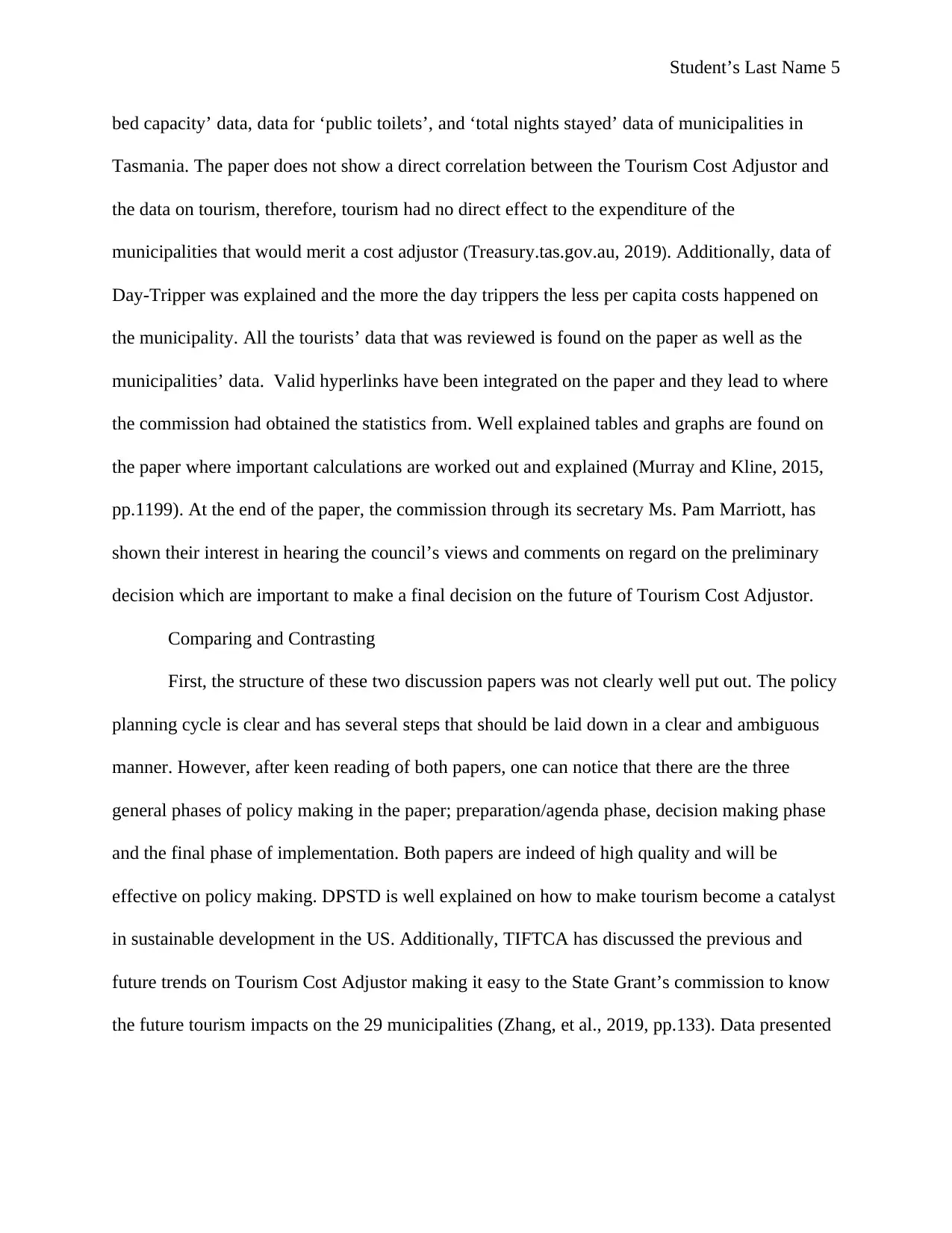
Student’s Last Name 5
bed capacity’ data, data for ‘public toilets’, and ‘total nights stayed’ data of municipalities in
Tasmania. The paper does not show a direct correlation between the Tourism Cost Adjustor and
the data on tourism, therefore, tourism had no direct effect to the expenditure of the
municipalities that would merit a cost adjustor (Treasury.tas.gov.au, 2019). Additionally, data of
Day-Tripper was explained and the more the day trippers the less per capita costs happened on
the municipality. All the tourists’ data that was reviewed is found on the paper as well as the
municipalities’ data. Valid hyperlinks have been integrated on the paper and they lead to where
the commission had obtained the statistics from. Well explained tables and graphs are found on
the paper where important calculations are worked out and explained (Murray and Kline, 2015,
pp.1199). At the end of the paper, the commission through its secretary Ms. Pam Marriott, has
shown their interest in hearing the council’s views and comments on regard on the preliminary
decision which are important to make a final decision on the future of Tourism Cost Adjustor.
Comparing and Contrasting
First, the structure of these two discussion papers was not clearly well put out. The policy
planning cycle is clear and has several steps that should be laid down in a clear and ambiguous
manner. However, after keen reading of both papers, one can notice that there are the three
general phases of policy making in the paper; preparation/agenda phase, decision making phase
and the final phase of implementation. Both papers are indeed of high quality and will be
effective on policy making. DPSTD is well explained on how to make tourism become a catalyst
in sustainable development in the US. Additionally, TIFTCA has discussed the previous and
future trends on Tourism Cost Adjustor making it easy to the State Grant’s commission to know
the future tourism impacts on the 29 municipalities (Zhang, et al., 2019, pp.133). Data presented
bed capacity’ data, data for ‘public toilets’, and ‘total nights stayed’ data of municipalities in
Tasmania. The paper does not show a direct correlation between the Tourism Cost Adjustor and
the data on tourism, therefore, tourism had no direct effect to the expenditure of the
municipalities that would merit a cost adjustor (Treasury.tas.gov.au, 2019). Additionally, data of
Day-Tripper was explained and the more the day trippers the less per capita costs happened on
the municipality. All the tourists’ data that was reviewed is found on the paper as well as the
municipalities’ data. Valid hyperlinks have been integrated on the paper and they lead to where
the commission had obtained the statistics from. Well explained tables and graphs are found on
the paper where important calculations are worked out and explained (Murray and Kline, 2015,
pp.1199). At the end of the paper, the commission through its secretary Ms. Pam Marriott, has
shown their interest in hearing the council’s views and comments on regard on the preliminary
decision which are important to make a final decision on the future of Tourism Cost Adjustor.
Comparing and Contrasting
First, the structure of these two discussion papers was not clearly well put out. The policy
planning cycle is clear and has several steps that should be laid down in a clear and ambiguous
manner. However, after keen reading of both papers, one can notice that there are the three
general phases of policy making in the paper; preparation/agenda phase, decision making phase
and the final phase of implementation. Both papers are indeed of high quality and will be
effective on policy making. DPSTD is well explained on how to make tourism become a catalyst
in sustainable development in the US. Additionally, TIFTCA has discussed the previous and
future trends on Tourism Cost Adjustor making it easy to the State Grant’s commission to know
the future tourism impacts on the 29 municipalities (Zhang, et al., 2019, pp.133). Data presented
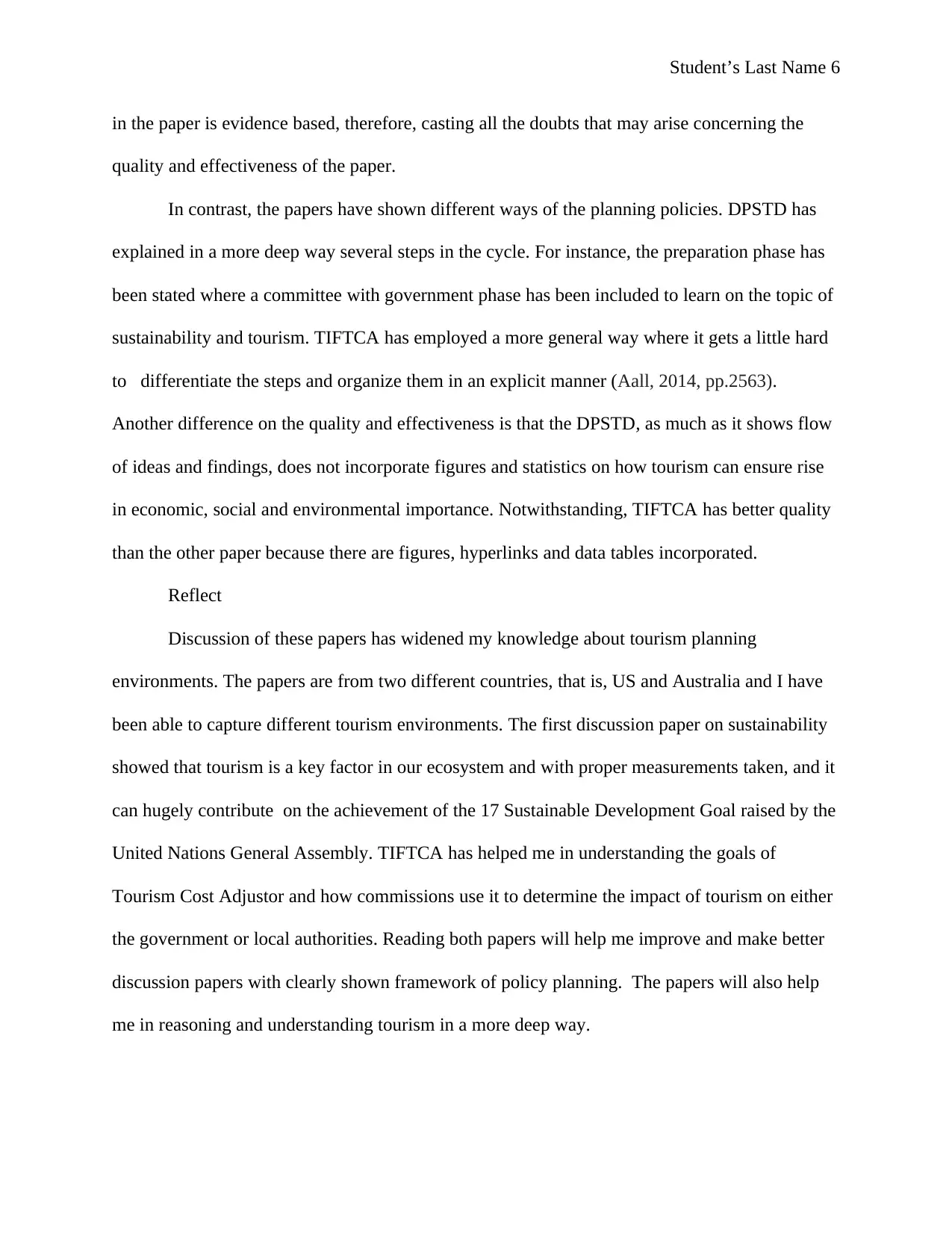
Student’s Last Name 6
in the paper is evidence based, therefore, casting all the doubts that may arise concerning the
quality and effectiveness of the paper.
In contrast, the papers have shown different ways of the planning policies. DPSTD has
explained in a more deep way several steps in the cycle. For instance, the preparation phase has
been stated where a committee with government phase has been included to learn on the topic of
sustainability and tourism. TIFTCA has employed a more general way where it gets a little hard
to differentiate the steps and organize them in an explicit manner (Aall, 2014, pp.2563).
Another difference on the quality and effectiveness is that the DPSTD, as much as it shows flow
of ideas and findings, does not incorporate figures and statistics on how tourism can ensure rise
in economic, social and environmental importance. Notwithstanding, TIFTCA has better quality
than the other paper because there are figures, hyperlinks and data tables incorporated.
Reflect
Discussion of these papers has widened my knowledge about tourism planning
environments. The papers are from two different countries, that is, US and Australia and I have
been able to capture different tourism environments. The first discussion paper on sustainability
showed that tourism is a key factor in our ecosystem and with proper measurements taken, and it
can hugely contribute on the achievement of the 17 Sustainable Development Goal raised by the
United Nations General Assembly. TIFTCA has helped me in understanding the goals of
Tourism Cost Adjustor and how commissions use it to determine the impact of tourism on either
the government or local authorities. Reading both papers will help me improve and make better
discussion papers with clearly shown framework of policy planning. The papers will also help
me in reasoning and understanding tourism in a more deep way.
in the paper is evidence based, therefore, casting all the doubts that may arise concerning the
quality and effectiveness of the paper.
In contrast, the papers have shown different ways of the planning policies. DPSTD has
explained in a more deep way several steps in the cycle. For instance, the preparation phase has
been stated where a committee with government phase has been included to learn on the topic of
sustainability and tourism. TIFTCA has employed a more general way where it gets a little hard
to differentiate the steps and organize them in an explicit manner (Aall, 2014, pp.2563).
Another difference on the quality and effectiveness is that the DPSTD, as much as it shows flow
of ideas and findings, does not incorporate figures and statistics on how tourism can ensure rise
in economic, social and environmental importance. Notwithstanding, TIFTCA has better quality
than the other paper because there are figures, hyperlinks and data tables incorporated.
Reflect
Discussion of these papers has widened my knowledge about tourism planning
environments. The papers are from two different countries, that is, US and Australia and I have
been able to capture different tourism environments. The first discussion paper on sustainability
showed that tourism is a key factor in our ecosystem and with proper measurements taken, and it
can hugely contribute on the achievement of the 17 Sustainable Development Goal raised by the
United Nations General Assembly. TIFTCA has helped me in understanding the goals of
Tourism Cost Adjustor and how commissions use it to determine the impact of tourism on either
the government or local authorities. Reading both papers will help me improve and make better
discussion papers with clearly shown framework of policy planning. The papers will also help
me in reasoning and understanding tourism in a more deep way.
⊘ This is a preview!⊘
Do you want full access?
Subscribe today to unlock all pages.

Trusted by 1+ million students worldwide
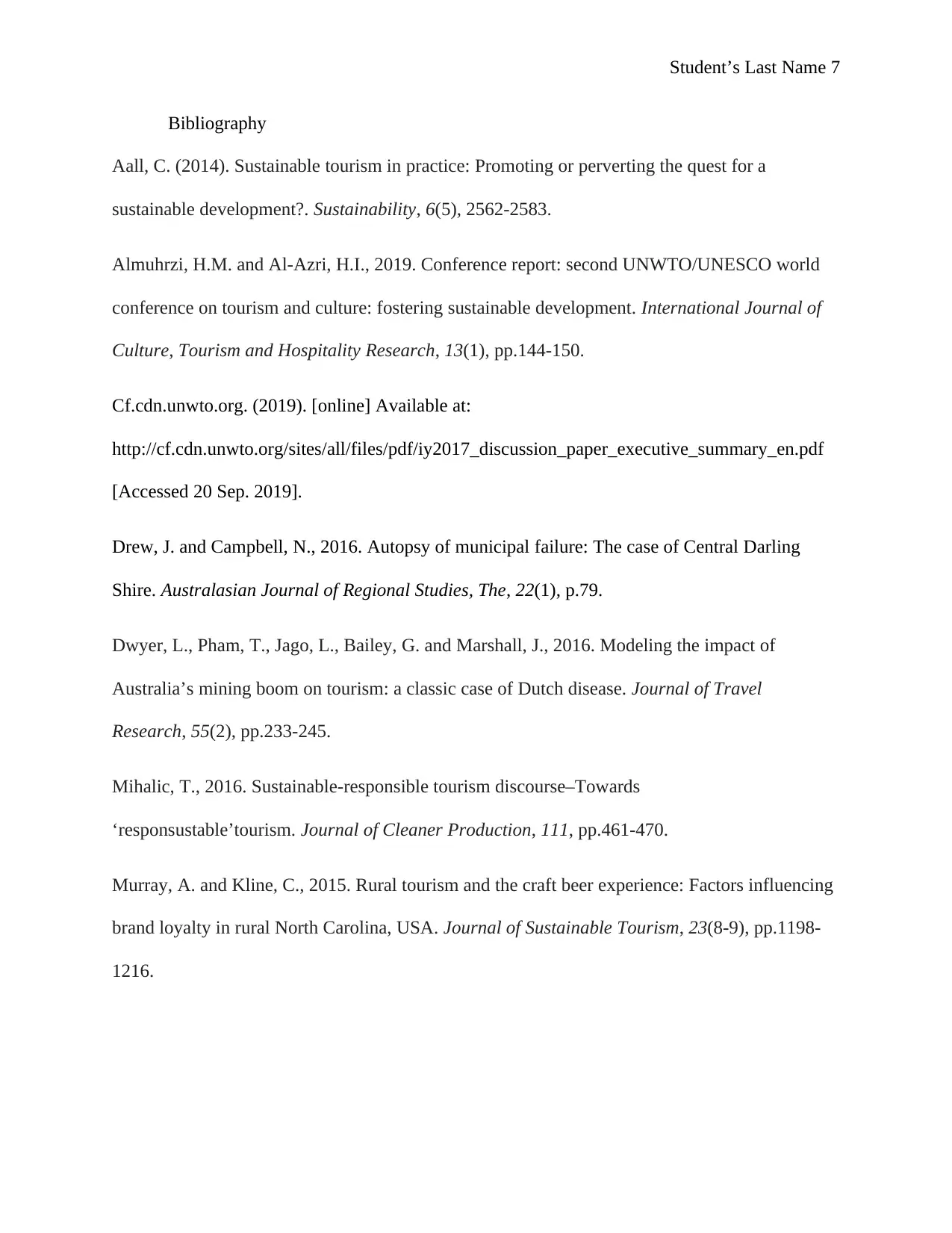
Student’s Last Name 7
Bibliography
Aall, C. (2014). Sustainable tourism in practice: Promoting or perverting the quest for a
sustainable development?. Sustainability, 6(5), 2562-2583.
Almuhrzi, H.M. and Al-Azri, H.I., 2019. Conference report: second UNWTO/UNESCO world
conference on tourism and culture: fostering sustainable development. International Journal of
Culture, Tourism and Hospitality Research, 13(1), pp.144-150.
Cf.cdn.unwto.org. (2019). [online] Available at:
http://cf.cdn.unwto.org/sites/all/files/pdf/iy2017_discussion_paper_executive_summary_en.pdf
[Accessed 20 Sep. 2019].
Drew, J. and Campbell, N., 2016. Autopsy of municipal failure: The case of Central Darling
Shire. Australasian Journal of Regional Studies, The, 22(1), p.79.
Dwyer, L., Pham, T., Jago, L., Bailey, G. and Marshall, J., 2016. Modeling the impact of
Australia’s mining boom on tourism: a classic case of Dutch disease. Journal of Travel
Research, 55(2), pp.233-245.
Mihalic, T., 2016. Sustainable-responsible tourism discourse–Towards
‘responsustable’tourism. Journal of Cleaner Production, 111, pp.461-470.
Murray, A. and Kline, C., 2015. Rural tourism and the craft beer experience: Factors influencing
brand loyalty in rural North Carolina, USA. Journal of Sustainable Tourism, 23(8-9), pp.1198-
1216.
Bibliography
Aall, C. (2014). Sustainable tourism in practice: Promoting or perverting the quest for a
sustainable development?. Sustainability, 6(5), 2562-2583.
Almuhrzi, H.M. and Al-Azri, H.I., 2019. Conference report: second UNWTO/UNESCO world
conference on tourism and culture: fostering sustainable development. International Journal of
Culture, Tourism and Hospitality Research, 13(1), pp.144-150.
Cf.cdn.unwto.org. (2019). [online] Available at:
http://cf.cdn.unwto.org/sites/all/files/pdf/iy2017_discussion_paper_executive_summary_en.pdf
[Accessed 20 Sep. 2019].
Drew, J. and Campbell, N., 2016. Autopsy of municipal failure: The case of Central Darling
Shire. Australasian Journal of Regional Studies, The, 22(1), p.79.
Dwyer, L., Pham, T., Jago, L., Bailey, G. and Marshall, J., 2016. Modeling the impact of
Australia’s mining boom on tourism: a classic case of Dutch disease. Journal of Travel
Research, 55(2), pp.233-245.
Mihalic, T., 2016. Sustainable-responsible tourism discourse–Towards
‘responsustable’tourism. Journal of Cleaner Production, 111, pp.461-470.
Murray, A. and Kline, C., 2015. Rural tourism and the craft beer experience: Factors influencing
brand loyalty in rural North Carolina, USA. Journal of Sustainable Tourism, 23(8-9), pp.1198-
1216.
Paraphrase This Document
Need a fresh take? Get an instant paraphrase of this document with our AI Paraphraser
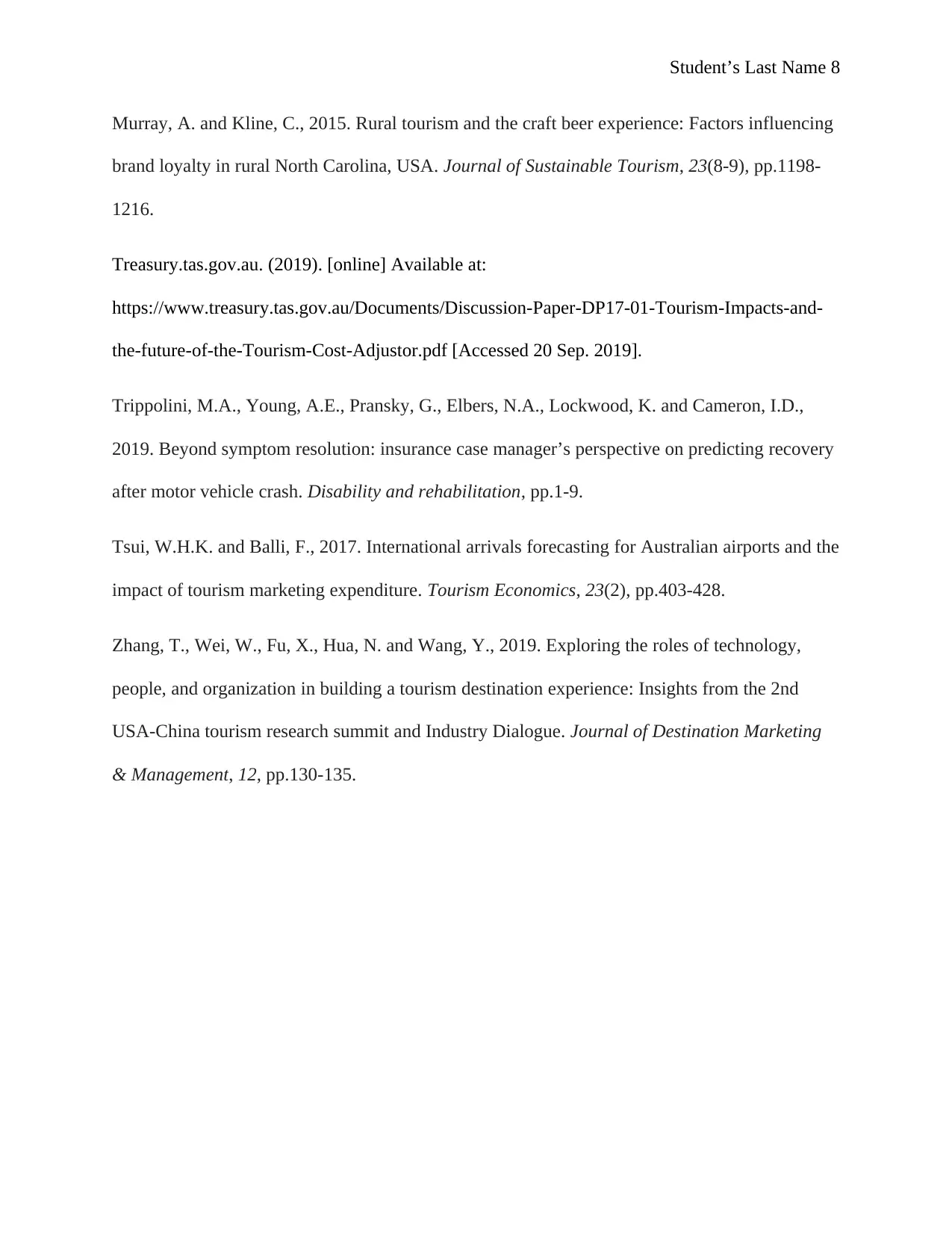
Student’s Last Name 8
Murray, A. and Kline, C., 2015. Rural tourism and the craft beer experience: Factors influencing
brand loyalty in rural North Carolina, USA. Journal of Sustainable Tourism, 23(8-9), pp.1198-
1216.
Treasury.tas.gov.au. (2019). [online] Available at:
https://www.treasury.tas.gov.au/Documents/Discussion-Paper-DP17-01-Tourism-Impacts-and-
the-future-of-the-Tourism-Cost-Adjustor.pdf [Accessed 20 Sep. 2019].
Trippolini, M.A., Young, A.E., Pransky, G., Elbers, N.A., Lockwood, K. and Cameron, I.D.,
2019. Beyond symptom resolution: insurance case manager’s perspective on predicting recovery
after motor vehicle crash. Disability and rehabilitation, pp.1-9.
Tsui, W.H.K. and Balli, F., 2017. International arrivals forecasting for Australian airports and the
impact of tourism marketing expenditure. Tourism Economics, 23(2), pp.403-428.
Zhang, T., Wei, W., Fu, X., Hua, N. and Wang, Y., 2019. Exploring the roles of technology,
people, and organization in building a tourism destination experience: Insights from the 2nd
USA-China tourism research summit and Industry Dialogue. Journal of Destination Marketing
& Management, 12, pp.130-135.
Murray, A. and Kline, C., 2015. Rural tourism and the craft beer experience: Factors influencing
brand loyalty in rural North Carolina, USA. Journal of Sustainable Tourism, 23(8-9), pp.1198-
1216.
Treasury.tas.gov.au. (2019). [online] Available at:
https://www.treasury.tas.gov.au/Documents/Discussion-Paper-DP17-01-Tourism-Impacts-and-
the-future-of-the-Tourism-Cost-Adjustor.pdf [Accessed 20 Sep. 2019].
Trippolini, M.A., Young, A.E., Pransky, G., Elbers, N.A., Lockwood, K. and Cameron, I.D.,
2019. Beyond symptom resolution: insurance case manager’s perspective on predicting recovery
after motor vehicle crash. Disability and rehabilitation, pp.1-9.
Tsui, W.H.K. and Balli, F., 2017. International arrivals forecasting for Australian airports and the
impact of tourism marketing expenditure. Tourism Economics, 23(2), pp.403-428.
Zhang, T., Wei, W., Fu, X., Hua, N. and Wang, Y., 2019. Exploring the roles of technology,
people, and organization in building a tourism destination experience: Insights from the 2nd
USA-China tourism research summit and Industry Dialogue. Journal of Destination Marketing
& Management, 12, pp.130-135.
1 out of 8
Related Documents
Your All-in-One AI-Powered Toolkit for Academic Success.
+13062052269
info@desklib.com
Available 24*7 on WhatsApp / Email
![[object Object]](/_next/static/media/star-bottom.7253800d.svg)
Unlock your academic potential
Copyright © 2020–2025 A2Z Services. All Rights Reserved. Developed and managed by ZUCOL.




